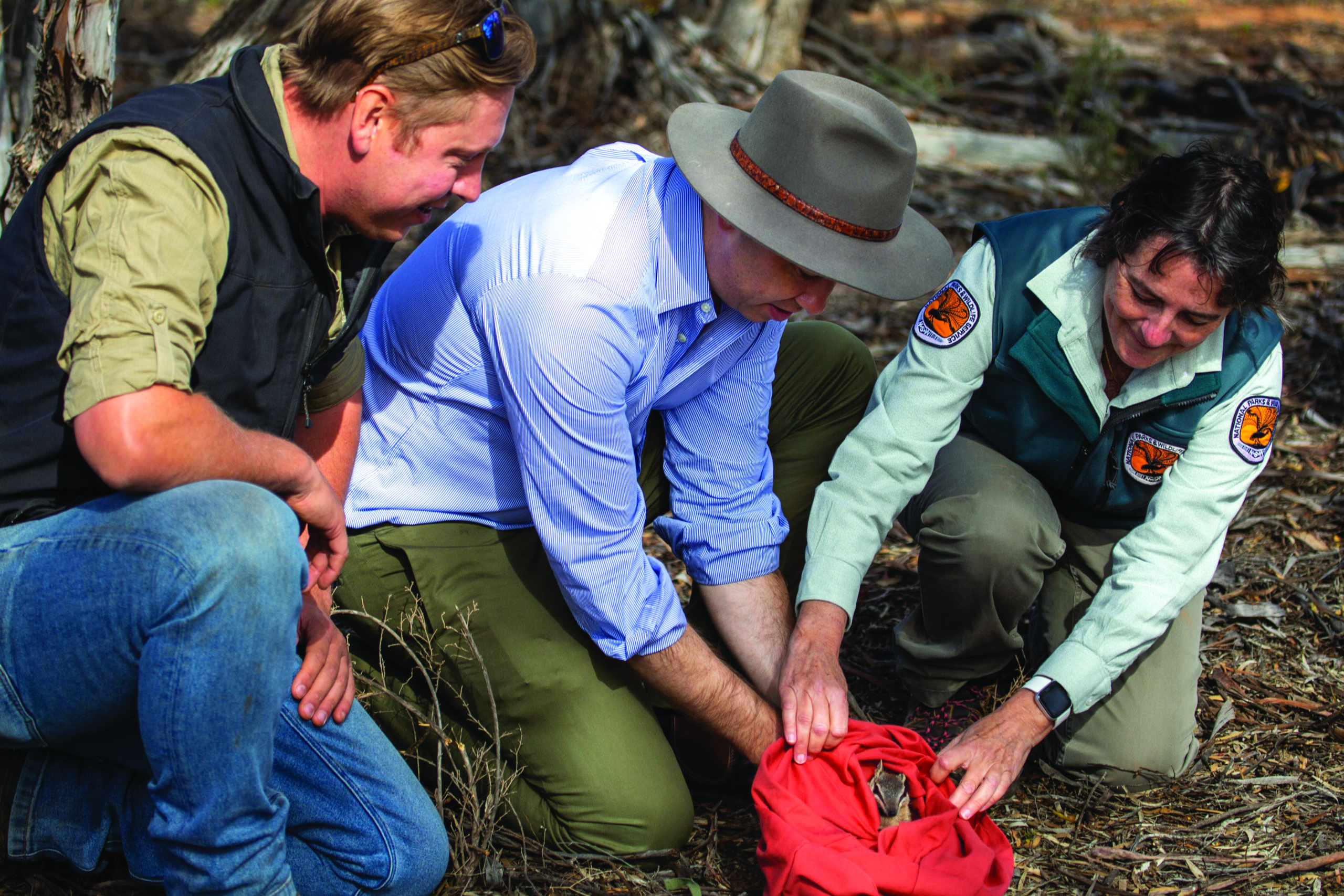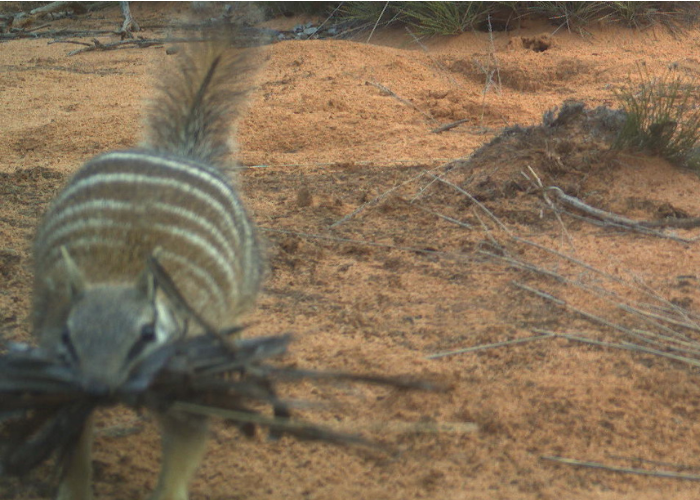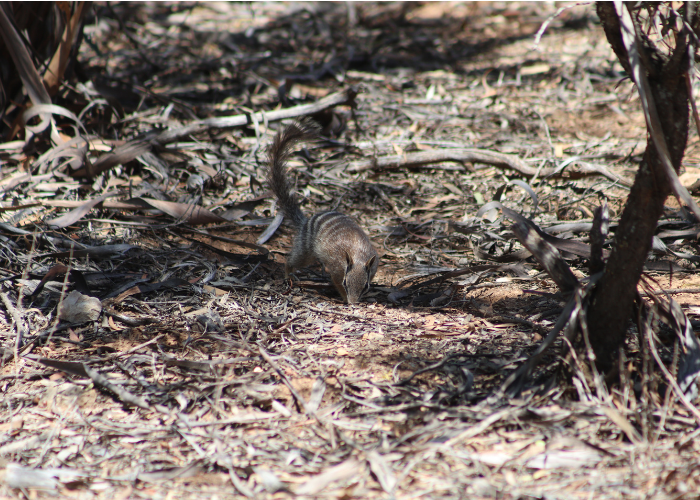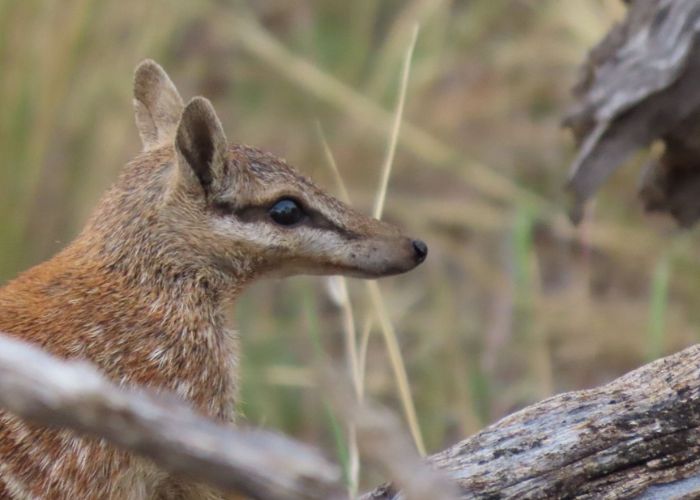Reintroduced populations of Australia’s endangered Numbat appear to be increasing within wildlife sanctuaries in the lower Murray Darling Basin, five years after the 2018/19 drought triggered a decline in populations. Ecologists at Australian Wildlife Conservancy (AWC) are hopeful that increased sightings of the species indicate that the populations are rebounding and returning to pre-drought levels.
The Numbat was absent in the Murray Darling Basin for over 100 years until 1993, when 15 individuals were released inside a 1,100 hectare feral predator-free fenced area at Yookamurra Wildlife Sanctuary on the land of Ngarrindjeri Nation in the south east of Australia. The Numbat reintroduction at Yookamurra was initiated by Earth Sanctuaries, before AWC took over management in 2002 and finished work on the feral predator-free area.
In 1999, another Numbat population was established at Scotia Wildlife Sanctuary on Barkandji country in far western NSW. The reintroduction consisted of 43 founders released inside a 4,000-hectare feral predator-free fenced area. The fenced area was then expanded to 8,000 hectares and a further 30 Numbats were released there in 2011-2012. By December 2020, a third population was established within the largest fenced cat and fox-free area on mainland Australia, in Mallee Cliffs National Park. In partnership with NSW National Parks and Wildlife Service, 15 Numbats were released in 2020, and joined by another 31 individuals in 2021 and 2022.

The fenced areas (known as safe havens) play a vitally important role in providing refuge to populations of reintroduced species, including the Numbat, from introduced predators such as feral cats and foxes.
During standardised surveys of the reintroduced Numbats ecologists recorded frequent sightings within the fenced areas until five years ago, when the Murray Darling region experienced its severest drought conditions in over 120 years. Numbat sightings were few and far between with the Yookamurra population dropping from an estimated 52 individuals in 2017 to just 25 in 2018, while Scotia’s population fell from an estimated 629 individuals in 2017 to 133 in 2018 and 83 in 2019.
Dr Alexandra Ross, AWC’s Acting Regional Ecologist for South Australia, said that the drop in Numbat sightings during the drought was reflective of wider trends in the environment at that time.
“Populations of native animals undergo natural cycles of boom and bust in response to prevailing conditions,” explained Dr Ross. “Australia’s variable climate leads to big fluctuations in numbers of small mammals from one year to the next. This holds true within AWC’s network of fenced safe havens.”
 Australian Wildlife Conservancy
Australian Wildlife Conservancy
Fortunately, wetter weather conditions and regrowth of vegetation over the last 12 months appear to have improved the small insectivore’s status at both Yookamurra and Scotia sanctuaries. Ecologists encountered 14 Numbats during an eight-day survey at Yookamurra in January this year, which produced a population estimate of 42 individuals, the highest estimate since before the drought. Meanwhile, Scotia’s population was estimated at 287 individuals following a survey in November 2023, more than double the 2019 low point.
While it’s too soon to calculate a population for Numbats in Mallee Cliffs where they are still becoming established, ecologists have had more incidental sightings in the last five months, with detections on camera traps also increasing, indicating that their numbers are growing.
Dr Ross was thrilled to see the Yookamurra population rebounding.
“Numbat surveys are usually conducted in November when sub-adults are leaving home to find new territories,” said Dr Ross. “We usually spot a few running along the safe haven’s fence line, but not in November last year. We encountered a total of three Numbats, two of which were outside the survey area.”
“The low number was a bit concerning, so we decided to resurvey the species in January, and were relieved when we saw multiple individuals almost daily.”
 Alexandra Ross/AWC
Alexandra Ross/AWC
The method of surveying Numbats involves driving along transect areas within the predator-proof fence. The transect areas are inspected twice a day – 30 minutes after sunrise when the temperature reaches at least 11 degrees, and again in the afternoon.
Dr Rachel Ladd, AWC Senior Wildlife Ecologist at Scotia, said that although surveying the diurnal species can be arduous, biodiversity monitoring is a key part of effective conservation at the sanctuaries.
“It’s pretty gratifying to think that across these three populations there are now hundreds of Numbats in this part of the country, where twenty-five years ago there were none,” said Dr Ladd. “It’s a thrill to get a glimpse of their little stripey backs as they trot through the mallee searching for termites.”
 Belinda Howe/AWC
Belinda Howe/AWC
The Numbat is a small, diurnal Australian mammal recognisable by its distinct striking rusty orange and grey-black fur. Once found across much of arid and semi-arid southern Australia, the species fell victim to habitat loss and introduced predators (cats and foxes), and now only two naturally occurring populations remain, both in south-west WA.
The species has an extremely specialised diet comprised almost exclusively of termites. As the sun rises and the day heats up, the temperature of the upper layers of soil increases, and termites move in to a network of shallow tunnels and chambers just below the ground surface. Numbats detect the termites with their acute sense of smell, and use their front paws to scrape away the soil and expose them, before licking them up with their long tongue.
For more information on AWC’s work with the Numbat, click here.
Support Australian Wildlife Conservancy's science-led conservation work and safeguard the future of Australia's native species
Donate Now